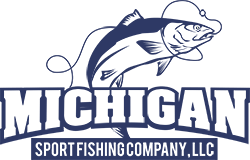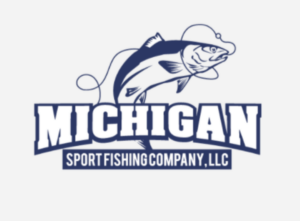
The North Coast, Northern Michigan Salmon Fishing
No matter where you live in the Midwest, any timely discussion of Great Lakes salmon fishing must take place in August. Fishing in late spring, especially for the perfectly-sized coho, is predictable but spotty due to inclement weather. Fall stream fishing is purely aesthetic, with the fiery maples and fragrant cedars whispering promise over currents of bronze; problem is that salmon fishing from rivers, in terms of quality table fare, are a few oozing stages beyond dumpster diving. Winter? You must be insane. No, for the overall best biting, best fighting, best eating salmon of the year—August.
That’s exactly why the Michigan Outdoor Report leaves the root-drying cornfields of southern Michigan for the quickening dune country of the north coast of Lake Michigan. We could focus on trolling for at-best medium-sized northern pike or sulky, deep bluegills on our inland waters, or even the burgeoning schools of smallmouth bass in Lakes St. Clair or Erie. But the list of why we sally forth north is short and sweet:
- Inland pike are not nearly as large as the average salmon,
- Bluegills are scarcely as feisty, and finally,
- Smallmouth bass are not even close to as tasty when blackened in a smoky, thick layer of Cajun seasoning.
The problems with salmon fishing the big water, in my mind, revolve solely around cost. First off, a large boat is not a suggestion, rather a fundamental safety requirement. Big boats require a lot of maintenance, insurance, gear, and a whole lot of fuel (I won’t even start off on that one!), therefore, chartering makes perfect sense for cash-conscious anglers. For between $600 and $800, pretty much anyone of sound mind can find a captain to take them fishing. Divide this cost among four anglers and the trip is downright cheap. (If you doubt this, do a quick search on salmon fishing charters for native fish in Alaska, and then caress your sobbing wallet.) From Jackson, figure about 2.5 hours to Ludington, another half-hour to Manistee. In a car that gets average gas mileage, expect a cost of around $40 for fuel. Stay overnight in the area the evening before the trip for a campsite fee of around $40, motels for about $100. Bring your own grub. Get a good guide and you’re likely to bring home a slug of beautifully orange salmon fillets and a mind full of memories at a great price by today’s standards.
Or you could go to Vegas and hand over your pension or 401K to some of our country’s wealthiest people so they can lavish themselves and their entourages with inconceivable extravagances in what is probably the most inhospitably sun-scorched , fly-buzzed and licentious section of desert in the United States. Better yet, let’s just keep our money, our morals, and our precious water right here in Michigan.
Summer Salmon Fishing – Unpredictability that Doesn’t Matter
 In early August, I made a salmon fishing trip to Manistee to fish with Captain John from Michigan Sport Fishing Charters. I arrived in port the night before, and made arrangements to do some waterside camping in the National Forest, but before I turned in I met with John to see how the fishing had been going. Strangely, I didn’t hear stories of fish holding out past 150 feet of water, as is par for this time of year. The salmon is a cold-water species, generally abandoning the heat in the upper column for the cool waters of the substrata. But something had changed.
In early August, I made a salmon fishing trip to Manistee to fish with Captain John from Michigan Sport Fishing Charters. I arrived in port the night before, and made arrangements to do some waterside camping in the National Forest, but before I turned in I met with John to see how the fishing had been going. Strangely, I didn’t hear stories of fish holding out past 150 feet of water, as is par for this time of year. The salmon is a cold-water species, generally abandoning the heat in the upper column for the cool waters of the substrata. But something had changed.
The lake endured some big blows that pushed the warm surface water away from shore to be replaced by an up welling of cold water. As a result of a more even distribution of the fish’s preferred temperature range, instead of being confined to their normal deep sanctuary haunts, salmon could roam at will. In the days just before my visit, local fishermen were cashing in close to shore in 20 feet of water or less—a result of cold water allowing the summer salmon to feed on concentrated, shallow forage. Even guys casting spoons from the rock slabs hooked and landed those shiny sanctuary salmon, fresh from the abyss.
On my night, the warm water had crept back to shore, but some pools of cooler water dawdled about in big bands within a mile of the pier heads. Before the reach of the rose-fingered dawn, we slipped into the fog and quietly set lines just beyond the harbor, idling north into the mist. It was a grey day; the air was thick and wet and pressed close enough to soak into rain gear, jeans and exposed skin. Any heat or comfort we derived while shrouded in the heavy mist emanated from the heart-warming hand of confidence. Working in fog can be an exercise in maintaining sanity, but our crew included three good boatsmen, and we were heading for the perceived playground, visible or not, of John’s Island.
Captain John’s Island
I can not provide the exact coordinates to this space out in the confusing blue void of Lake Michigan, and probably wouldn’t, given both the selfishness of my inner angler and an undying respect for someone else’s hot spot, even if it were possible.  But the real difficulty in describing John’s Island, both in terms of size and location, stems from two insurmountable facts: It’s invisible, and it moves. John’s Island has no trees or plovers, no houses or roads, no litter or sand or landlocked bedrock to hold it in place. It takes the tendencies of an ambling child; free to run from land, wind, warm water, and most problems surrounding humanity. It’s a site away from the crowds, floating unaware of the hassle and headache of boats and people who are either too dull or insensitive to know they’re screwing things up for everyone else.
But the real difficulty in describing John’s Island, both in terms of size and location, stems from two insurmountable facts: It’s invisible, and it moves. John’s Island has no trees or plovers, no houses or roads, no litter or sand or landlocked bedrock to hold it in place. It takes the tendencies of an ambling child; free to run from land, wind, warm water, and most problems surrounding humanity. It’s a site away from the crowds, floating unaware of the hassle and headache of boats and people who are either too dull or insensitive to know they’re screwing things up for everyone else.
John’s Island sits twenty miles due west of shore in the deep Michigan blue; sometimes it floats seven miles north, straddling a break line unburdened by pleasure craft and angling spreads; sometimes, in those rare times, it’s right outside the pier head , holding smack on the same subsurface rills collecting spring brown trout. There is a better place to fish, out there, away from the rivers and the congestion and the shouts and extended fingers. It’s called John’s Island, and it’s wherever no one else is.
Despite the hoodoo of popular thinking, John’s Island holds plenty of fish. Radar helped us find the path through the phalanx in the fog, narrowly averting a couple of circling shallow water boats. Soon, though well outside the confusion, with a handful of lines down, we were heading for the tranquil waters surrounding his place. Just off shore, in thirty-five feet of water, the first rod popped. I grabbed the Dipsey rig out of the port side holder and tried to keep the fish from crossing lines by steering him toward the center of the boat. Line kept paying out in long, violent pulls, so I tightened the drag oh-so-slightly to keep the fish from fouling other lines. A fat mistake. Two more tugs and the heavy fish ripped free from the hooks. Sheepishly, I raised my hand to accept my punishment, reeled in the lonely lure, and went and sat in the corner.
I had assumed that, like many charter captains I’ve run into, all the reels were equipped with stretchy monofilament line, and that tacking down the drag would shorten the fish’s runs without compromising shock absorption qualities. As I’ve been blessed to learn over the years that Kutcha theory usually ends in disaster. John uses a no-stretch braided line on his Dipsey reels, so the only thing from keeping hooks in place is a bent rod and light drag. The rod did its job perfectly, but the Bozo on the controls did not. That taught me to pay more attention to John’s equipment, and to ask questions if I had any. After that initial screw-up, things went much more smoothly.
After dogging myself for about five minutes, another rod popped and a scrappy, ten-pound king came to net. Fifteen minutes later, another spunky salmon took and went into the cooler. Fifteen minutes more, same thing. And so on it went until about 10 o’clock, when we took hits once about every half-hour. A pair of beautiful ten-pound steelhead even climbed on to complement a limit of kings.
John’s Island is a godsend most days. With plenty of fish and a good captain to find it, the Lake Michigan experience is exciting, relaxing and fulfilling. But I think that what keeps me going back is that even if every other big-water angler catches on to the concept, John’s Island will still be there next time, and the next time, and the next time I visit. And that is always a good reason to think about August’s northern Michigan salmon fishing from southern Michigan.
Call to schedule a northern Michigan salmon charter with Captain John Today!
- Fishing
- February 7, 2021






